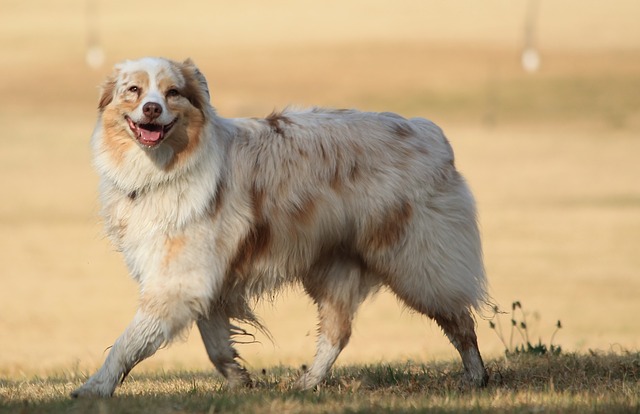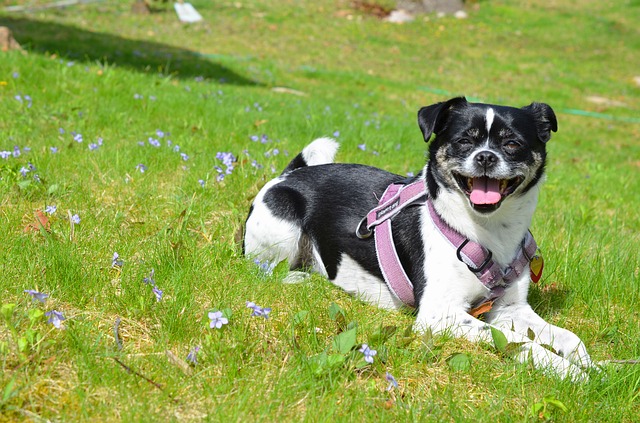There are 4 basic canine facial expressions humans have come to interpret as “smiles”. While dogs share many of our complex emotions, they do not necessarily display them in the same ways.
An open mouth and upturned lips can definitely be a sign of happiness and relaxation, but it can also indicate stress, fear or submission. In order to interpret canine smiles, we must take into account the language of the entire body.

Robin Bennett, CPDT-KA, co-author of Off Leash Dog Play and Knowing Dogs Staff Training, is an expert at canine body language. She told iHeartDogs:
“I don’t really think dogs smile the way we think of smiling. However, it is true that when dogs are relaxed and panting many people call that smiling. In terms of body language, panting is usually a sign that the dog is comfortable and happy, so many times a panting dog is a happy dog, assuming the dog’s overall body is also relaxed.”
1. The Relaxed Grin

A true facial expression of contentedness usually includes soft or squinted eyes and lips that appear relaxed and loose rather than harshly pulled back. The facial muscles are also relaxed with ears that sit normally on the head – not pinned back against the skull.
The body language accompanying a happy dog smile is loose with a gently wagging tail and possibly a “happy dance” if the grin is brought on by a play session or the arrival of a favorite human.
A relaxed grin can often be seen when a dog lays down to rest after exercise. Their minds and bodies are loose and free of stress and it shows in their soft facial expression.
“In terms of body language, relaxed muscles are seen when a dog is safe and comfortable,” Bennett explains. “If they are in that sort of state they can also relax and play. So I think it’s more a level of safety and comfort when a dog appears ‘happy’ or ‘smiling’.”
2. The Not-So-Relaxed Grin

In the photo above, the dog’s ears are pulled back tightly and the tension of the facial muscles can be seen around the corners of the mouth. This appears to be stress-related panting, not happy panting. The eyes are also wide with the whites showing, an expression of stress often described as “whale-eyes“.
The dog’s head is pulled far back on the neck, indicating tension and a desire to retreat from the camera. While the body cannot be seen, the limbs are likely stiff and tense.
3. The Submissive Grin (aka: The Canine Grimace)
Dogs use the submissive grin as an appeasement gesture when feeling uncomfortable. The lips are tightly retracted revealing a mouthful of pearly whites. The ears are pinned back, the eyes are wide in nervous anticipation, and the body is tense.
While it may look intimidating, the canine grimace is not the same as an aggressive snarl. However, it does indicate the dog is feeling intimidated, so you should proceed with caution, especially if it is a pooch you do not know well.
Many of the videos you see online – including the one above – are taken from a high angle, with the person holding the camera over the dog. Since they do not know phones and cameras are harmless, having one looming over their head can make them feel quite nervous.
The dog in this video was rescued from a neglectful home where he was likely kept in a cage most of the time. His timid grin indicates his desire to please his new foster family and his lingering insecurities.
4. The Learned Grin
Dogs have a desire to please and a high capacity for learning, so what begins as a submissive smile can easily become a new “trick” when it is reinforced with treats and praise.
The dog below has learned to smile on cue. Her ears, face and body remain relaxed as she pulls back her lips on command to the delight of her owners.
Dog smiles can be quite confusing for humans who do not “speak dog”. We have a tendency to project our own emotions onto them and interpret their behavior and body language in the same way we would a fellow human’s. This phenomenon is known as anthropomorphism.
While anthropomorphism is mostly harmless, it can be dangerous if a dog’s warning signals are not interpreted correctly. For example, a submissive grin could be a dog’s way of saying, “I don’t like this, I’m stressed, please stop.” If their warning is not heeded, some dogs may escalate to fear biting.
Research conducted by the University of Lincoln in partnership with the Blue Dog Trust found that the majority of children ages 4-7 misinterpret dog snarls for smiles, putting them at high risk for bites.
In addition, many dog smiles are accompanied by wagging tails. When it comes to canine body language, the tail is a very expressive appendage, and wagging does not always indicate happiness. Depending on the height of the tail and the speed of the wagging, this gesture could signify uncertainty, fear or even an aggressive challenge.
Click here to learn more about “smiling” and other canine body language signals that are often misinterpreted.
Featured Image: Ian Ransley Graphic Design via Flickr
